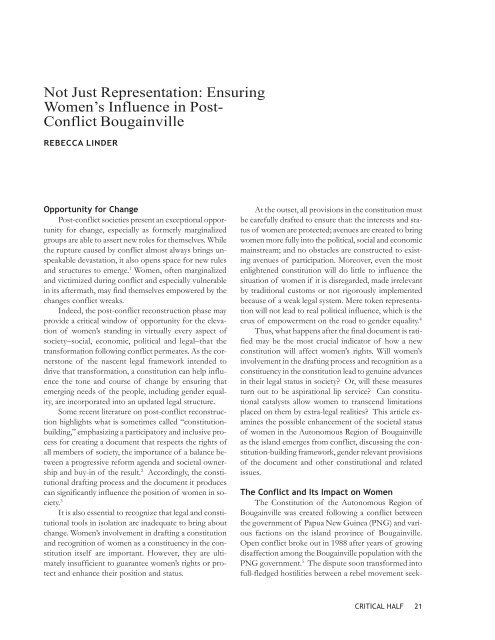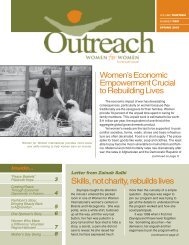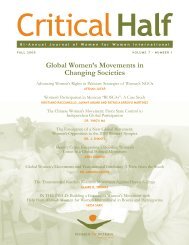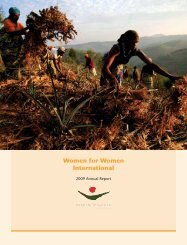Gender and Constitution Building - Women for Women International
Gender and Constitution Building - Women for Women International
Gender and Constitution Building - Women for Women International
You also want an ePaper? Increase the reach of your titles
YUMPU automatically turns print PDFs into web optimized ePapers that Google loves.
Not Just Representation: Ensuring<br />
<strong>Women</strong>’s Influence in Post-<br />
Conflict Bougainville<br />
REBECCA LINDER<br />
Opportunity <strong>for</strong> Change<br />
Post-conflict societies present an exceptional opportunity<br />
<strong>for</strong> change, especially as <strong>for</strong>merly marginalized<br />
groups are able to assert new roles <strong>for</strong> themselves. While<br />
the rupture caused by conflict almost always brings unspeakable<br />
devastation, it also opens space <strong>for</strong> new rules<br />
<strong>and</strong> structures to emerge. 1 <strong>Women</strong>, often marginalized<br />
<strong>and</strong> victimized during conflict <strong>and</strong> especially vulnerable<br />
in its aftermath, may find themselves empowered by the<br />
changes conflict wreaks.<br />
Indeed, the post-conflict reconstruction phase may<br />
provide a critical window of opportunity <strong>for</strong> the elevation<br />
of women’s st<strong>and</strong>ing in virtually every aspect of<br />
society–social, economic, political <strong>and</strong> legal–that the<br />
trans<strong>for</strong>mation following conflict permeates. As the cornerstone<br />
of the nascent legal framework intended to<br />
drive that trans<strong>for</strong>mation, a constitution can help influence<br />
the tone <strong>and</strong> course of change by ensuring that<br />
emerging needs of the people, including gender equality,<br />
are incorporated into an updated legal structure.<br />
Some recent literature on post-conflict reconstruction<br />
highlights what is sometimes called “constitutionbuilding,”<br />
emphasizing a participatory <strong>and</strong> inclusive process<br />
<strong>for</strong> creating a document that respects the rights of<br />
all members of society, the importance of a balance between<br />
a progressive re<strong>for</strong>m agenda <strong>and</strong> societal ownership<br />
<strong>and</strong> buy-in of the result. 2 Accordingly, the constitutional<br />
drafting process <strong>and</strong> the document it produces<br />
can significantly influence the position of women in society.<br />
3<br />
It is also essential to recognize that legal <strong>and</strong> constitutional<br />
tools in isolation are inadequate to bring about<br />
change. <strong>Women</strong>’s involvement in drafting a constitution<br />
<strong>and</strong> recognition of women as a constituency in the constitution<br />
itself are important. However, they are ultimately<br />
insufficient to guarantee women’s rights or protect<br />
<strong>and</strong> enhance their position <strong>and</strong> status.<br />
At the outset, all provisions in the constitution must<br />
be carefully drafted to ensure that: the interests <strong>and</strong> status<br />
of women are protected; avenues are created to bring<br />
women more fully into the political, social <strong>and</strong> economic<br />
mainstream; <strong>and</strong> no obstacles are constructed to existing<br />
avenues of participation. Moreover, even the most<br />
enlightened constitution will do little to influence the<br />
situation of women if it is disregarded, made irrelevant<br />
by traditional customs or not rigorously implemented<br />
because of a weak legal system. Mere token representation<br />
will not lead to real political influence, which is the<br />
crux of empowerment on the road to gender equality. 4<br />
Thus, what happens after the final document is ratified<br />
may be the most crucial indicator of how a new<br />
constitution will affect women’s rights. Will women’s<br />
involvement in the drafting process <strong>and</strong> recognition as a<br />
constituency in the constitution lead to genuine advances<br />
in their legal status in society? Or, will these measures<br />
turn out to be aspirational lip service? Can constitutional<br />
catalysts allow women to transcend limitations<br />
placed on them by extra-legal realities? This article examines<br />
the possible enhancement of the societal status<br />
of women in the Autonomous Region of Bougainville<br />
as the isl<strong>and</strong> emerges from conflict, discussing the constitution-building<br />
framework, gender relevant provisions<br />
of the document <strong>and</strong> other constitutional <strong>and</strong> related<br />
issues.<br />
The Conflict <strong>and</strong> Its Impact on <strong>Women</strong><br />
The <strong>Constitution</strong> of the Autonomous Region of<br />
Bougainville was created following a conflict between<br />
the government of Papua New Guinea (PNG) <strong>and</strong> various<br />
factions on the isl<strong>and</strong> province of Bougainville.<br />
Open conflict broke out in 1988 after years of growing<br />
disaffection among the Bougainville population with the<br />
PNG government. 5 The dispute soon trans<strong>for</strong>med into<br />
full-fledged hostilities between a rebel movement seek-<br />
CRITICAL HALF 21







